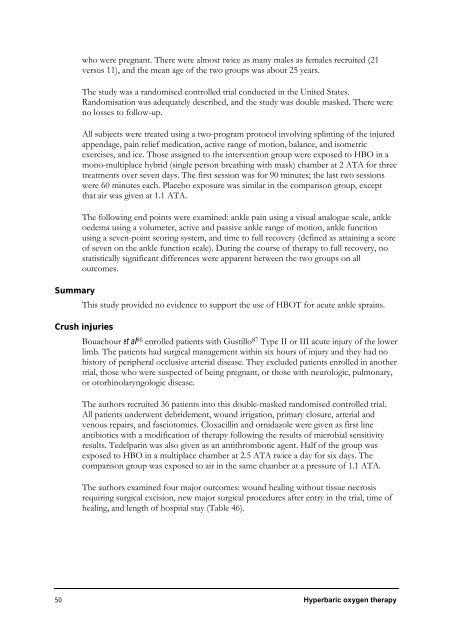Hyperbaric Oxygen Therapy - Hyperbaric Chamber Information ...
Hyperbaric Oxygen Therapy - Hyperbaric Chamber Information ...
Hyperbaric Oxygen Therapy - Hyperbaric Chamber Information ...
Create successful ePaper yourself
Turn your PDF publications into a flip-book with our unique Google optimized e-Paper software.
who were pregnant. There were almost twice as many males as females recruited (21<br />
versus 11), and the mean age of the two groups was about 25 years.<br />
The study was a randomised controlled trial conducted in the United States.<br />
Randomisation was adequately described, and the study was double masked. There were<br />
no losses to follow-up.<br />
All subjects were treated using a two-program protocol involving splinting of the injured<br />
appendage, pain relief medication, active range of motion, balance, and isometric<br />
exercises, and ice. Those assigned to the intervention group were exposed to HBO in a<br />
mono-multiplace hybrid (single person breathing with mask) chamber at 2 ATA for three<br />
treatments over seven days. The first session was for 90 minutes; the last two sessions<br />
were 60 minutes each. Placebo exposure was similar in the comparison group, except<br />
that air was given at 1.1 ATA.<br />
The following end points were examined: ankle pain using a visual analogue scale, ankle<br />
oedema using a volumeter, active and passive ankle range of motion, ankle function<br />
using a seven-point scoring system, and time to full recovery (defined as attaining a score<br />
of seven on the ankle function scale). During the course of therapy to full recovery, no<br />
statistically significant differences were apparent between the two groups on all<br />
outcomes.<br />
Summary<br />
This study provided no evidence to support the use of HBOT for acute ankle sprains.<br />
Crush injuries<br />
Bouachour et al86 enrolled patients with Gustillo87 Type II or III acute injury of the lower<br />
limb. The patients had surgical management within six hours of injury and they had no<br />
history of peripheral occlusive arterial disease. They excluded patients enrolled in another<br />
trial, those who were suspected of being pregnant, or those with neurologic, pulmonary,<br />
or otorhinolaryngologic disease.<br />
The authors recruited 36 patients into this double-masked randomised controlled trial.<br />
All patients underwent debridement, wound irrigation, primary closure, arterial and<br />
venous repairs, and fasciotomies. Cloxacillin and ornidazole were given as first line<br />
antibiotics with a modification of therapy following the results of microbial sensitivity<br />
results. Tedelparin was also given as an antithrombotic agent. Half of the group was<br />
exposed to HBO in a multiplace chamber at 2.5 ATA twice a day for six days. The<br />
comparison group was exposed to air in the same chamber at a pressure of 1.1 ATA.<br />
The authors examined four major outcomes: wound healing without tissue necrosis<br />
requiring surgical excision, new major surgical procedures after entry in the trial, time of<br />
healing, and length of hospital stay (Table 46).<br />
50 <strong>Hyperbaric</strong> oxygen therapy



